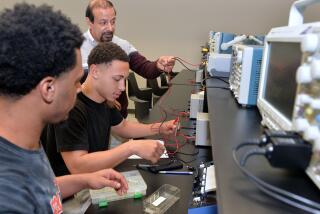Poor kids aren’t dolts -- push them harder
- Share via
TEACH FOR America recently asked 2,000 of our corps members whether they feel that the public understands the causes of the educational achievement gap that persists along socioeconomic and racial lines in this nation, and if they think people have a grasp of the right solutions.
These enterprising teachers are top recent college graduates of all academic majors who have committed two years to educating students in our nation’s lowest-income urban and rural communities. They are in the trenches, witnessing the problems of education with fresh eyes. And 98% of them answered the above questions with a “no.”
Apparently, they were right about the public’s views. According to the annual Phi Delta Kappa/Gallup survey, the most recent of which was released in September, most Americans cite a lack of parental involvement, as well as problems in students’ home life and upbringing and their lack of interest and motivation as the most important reasons for the huge gap between the achievement levels of students in upper- and middle-class neighborhoods and those in poor neighborhoods.
More than 75% of those polled said they believe that white students and students of color have the same academic opportunities.
In contrast, Teach for America corps members, who are in those poor neighborhoods every school day, say the key to closing that gap is to train and employ better teachers and improve the quality of the leaders who make decisions in schools and school districts -- while simultaneously ensuring that teachers, principals and parents expect the kids to meet challenging academic standards.
It is discouraging that such a gulf exists between the opinions of those outside the system and those on the front lines. But I find great cause for hope in the perspective of our program’s young teachers.
A system that allows 9-year-olds in low-income communities to achieve at levels three to four years behind their peers in more affluent communities is broken.
A system that allows black high school graduates, on average, to read at the level of white eighth-graders is an affront to our most fundamental ideals as a nation.
A system that allows children in families that earn less than $35,000 a year a mere 1-in-17 chance of completing college mocks our vision of equal opportunity for all.
For years, education and policy leaders have debated whether schools can affect student achievement levels in the face of abject poverty. Teach for America members, working in classrooms that some consider hopeless, conclude that even poor children who have fallen behind academically can succeed in school. These teachers tell us that we can develop educational environments that enable children growing up in low-income areas to achieve academically. What’s interesting is that the longer members have been teaching, the greater their faith that even disadvantaged students can do well.
These teachers, who forged their opinions in the communities and classrooms that have been plagued by the achievement gap, know what they’re talking about when they say that it is within the power of our policymakers and educational leaders to overcome the cycle of poverty. By building schools and school systems with great leadership, committed and talented teachers and high academic standards for all students, we can close the achievement gap.






